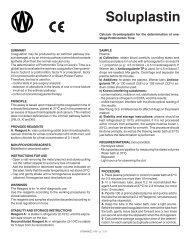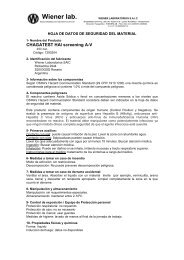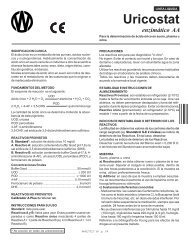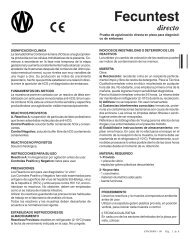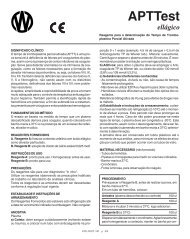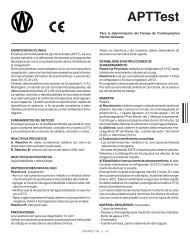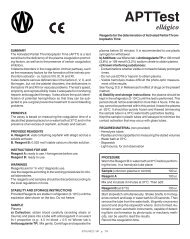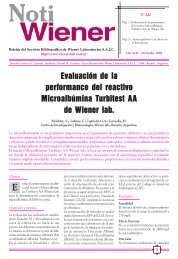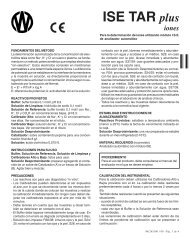HDL Colesterol Rvo. Precipitante - Wiener lab
HDL Colesterol Rvo. Precipitante - Wiener lab
HDL Colesterol Rvo. Precipitante - Wiener lab
You also want an ePaper? Increase the reach of your titles
YUMPU automatically turns print PDFs into web optimized ePapers that Google loves.
C<br />
SUMMARY<br />
Plasma lipoproteins are spherical particles containing varying<br />
amounts of cholesterol, triglycerides, phospholipids and<br />
proteins. These particles solubilize and transport cholesterol<br />
into the bloodstream. The relative proportion of protein and<br />
lipid determines the density of these lipoproteins.<br />
The main role of high density lipoprotein (<strong>HDL</strong>) in lipid metabolism<br />
is the uptake and transport of cholesterol from peripheral<br />
tissues to the liver through a process known as reverse<br />
cholesterol transport (cardioprotective mechanism).<br />
Low <strong>HDL</strong>-cholesterol levels are associated with an increased<br />
risk of coronary heart disease. Therefore, the determination<br />
of serum <strong>HDL</strong>-cholesterol is a useful tool for identifying highrisk<br />
patients.<br />
PRINCIPLE<br />
High-density lipoproteins (<strong>HDL</strong>) are separated selectively precipitating<br />
the low and very-low-density lipoproteins (LDL and<br />
VLDL) by adding MW 50,000 dextran sulfate in the presence<br />
of Mg + ions.<br />
In the supernatant, separated by centrifugation, the <strong>HDL</strong> remain<br />
and the determination of cholesterol associated to them<br />
is performed using the enzymatic system cholesterol-oxidase/<br />
peroxidase with Trinder colorimetry (Phenol/4-Aminophenazone).<br />
PROVIDED REAGENTS<br />
A. Reagent A: 0.032 mmol/l (50,000 MW) dextran sulfate<br />
solution.<br />
B. Reagent B: 1.5 M magnesium chloride solution.<br />
NON-PROVIDED REAGENTS<br />
<strong>Wiener</strong> <strong>lab</strong>.'s Colestat enzimático Colestat enzimático AA<br />
or Colestat enzimático AA Línea Líquida.<br />
INSTRUCTIONS FOR USE<br />
Precipitating Reagent (A+B); preparation: in the provided<br />
bottle, measure 2.5 ml of Reagent A and 2.5 ml Reagent B.<br />
Mix by inversion, <strong>lab</strong>el and date.<br />
Small quantities can be prepared according to what is needed,<br />
following the 1+1 proportion for both reagents.<br />
WARNINGS<br />
Reagents are for “in vitro” diagnostic use.<br />
Use the reagents according to the working procedures for<br />
clinical <strong>lab</strong>oratories.<br />
The reagents and samples should be discarded according to<br />
the local regulations in force.<br />
<strong>HDL</strong> <strong>Colesterol</strong><br />
Reactivo <strong>Precipitante</strong><br />
870630022 / 00 p. 7/9<br />
For <strong>HDL</strong>-cholesterol separation in serum or plasma<br />
STABILITY AND STORAGE INSTRUCTIONS<br />
Provided Reagents: stable at room temperature until the<br />
expiration date shown on the box.<br />
Precipitating Reagent: is stable for 6 months at room temperature<br />
and 1 year in refrigerator (2-10 o C) since preparation<br />
date.<br />
INSTABILITY OR DETERIORATION OF REAGENTS<br />
Any trace of bacterial contamination may be a sign of deterioration<br />
of the reagents.<br />
SAMPLE<br />
Serum or plasma<br />
a) Collection: obtain the sample in the usual way.<br />
b) Additives: if plasma is used, collect only with heparin.<br />
c) Known interfering substances: anticoagulants other than<br />
heparin and bilirubinemia over 50 mg/l interfere.<br />
See Young, D.S. in References for effect of drugs on the present<br />
method.<br />
d) Stability and storage instructions: separate serum within<br />
one hour from extraction. The Lipid Research Clinics recommend<br />
refrigerating the sample until the test is performed. The<br />
storage or conservation of the samples at room temperature<br />
alters their lipoprotein composition, within 24 hours. Some<br />
authors mention a stability of 3 days at 4 o C that is extended<br />
when frozen, but there is a large variability between different<br />
samples, therefore, it is recommended to keep the sample<br />
refrigerated and to process it within 24 hours.<br />
REQUIRED MATERIAL (non-provided)<br />
- Spectrophotometer or photocolorimeter.<br />
- Micropipettes and pipettes<br />
- Kahn tubes.<br />
- Tubes or spectrophotometric cuvettes.<br />
- Water bath at 37 o C.<br />
- Stopwatch.<br />
ASSAY CONDITIONS<br />
- Wavelength: 505 nm in spectrophotometer or 490-530 nm in<br />
photocolorimeter with green filter.<br />
- Reaction temperature: 37 o C<br />
- Reaction time: 45 minutes<br />
- Sample volume: 500 ul<br />
- Precipitating Reagent volume: 50 ul<br />
- Supernatant volume: 100 ul<br />
- Working Reagent volume of Colestat enzimático or Colestat<br />
enzimático AA/Línea Líquida: 2 ml<br />
- Final reaction volume: 2.1 ml
PROCEDURE<br />
In a Kahn tube measure 0.5 ml (500 ul) sample and add 50 ul<br />
Precipitating Reagent. Homogenize by shaking (not by inversion)<br />
for 20 seconds and place for 30-40 minutes in refrigerator<br />
(2-10 o C) or 15 minutes in water bath at that temperature.<br />
Do not freeze. Centrifuge 15 minutes at 3000 rpm.<br />
Use the clean supernatant as sample.<br />
In three tubes <strong>lab</strong>eled B (Blank), S (Standard) and U (Unknown)<br />
place:<br />
B S U<br />
Supernatant - - 100 ul<br />
Standard - 20 ul -<br />
Working Reagent 2 ml 2 ml 2 ml<br />
Mix and incubate for 5 minutes at 37oC, if the Working<br />
Reagent of Colestat enzimático AA/Línea Líquida is<br />
used or 15 minutes at 37oC if Colestat enzimático Working<br />
Reagent is employed. Remove from bath and let cool.<br />
Read at 505 nm in spectrophotometer or at 490-530 nm in<br />
photocolorimeter with green filter, setting the instrument to<br />
zero with the Blank.<br />
STABILITY OF FINAL REACTION<br />
The reaction color is stable for 2 hours, thus the absorbance<br />
must be read within that period.<br />
CALCULATIONS<br />
<strong>HDL</strong> Cholesterol (g/l) = U x f f =<br />
FV E RV E V Std<br />
0.457 = 2 (g/l) x x x<br />
V S RV Std V E<br />
0.457<br />
FV = extract final volume = 0.55 ml<br />
E<br />
V = processed sample volume = 0.5 ml<br />
S<br />
RV = reaction volume with extract = 2.1 ml<br />
E<br />
RV = reaction volume with Standard = 2.02 ml<br />
Std<br />
V = Standard volume in the reaction = 0.020 ml<br />
Std<br />
V = extract volume in the reaction = 0.1 ml<br />
E<br />
If Reagent volumes other than 2 ml are used, the 0.457 factor<br />
varies and must be calculated again, replacing VR and VR E S<br />
in the formula.<br />
REFERENCE VALUES<br />
The National Cholesterol Education Program (NCEP) Expert<br />
Panel provided the following reference values:<br />
0.40 - 0.60 g/l<br />
It is recommended that each <strong>lab</strong>oratory establishes its own<br />
reference values. However, values over 0.40 g/l are recommended<br />
and the ones over 0.60 g/l have been regarded as protective.<br />
On the contrary, <strong>HDL</strong>-cholesterol values below 0.40 g/l are<br />
considered as an indicator of coronary heart disease risk.<br />
S<br />
870630022 / 00 p. 8/9<br />
PROCEDURE LIMITATIONS<br />
See Known interfering substances under SAMPLE.<br />
The accuracy and precision of the determination mainly depend<br />
on following the precipitation conditions, thus, the established<br />
times and temperatures must be followed, although<br />
they do not need a strict control.<br />
When the <strong>HDL</strong> cholesterol cannot be completely separated in<br />
a common centrifuge, due to high levels of triglycerides, the<br />
determination can be performed as follows:<br />
Follow the instructions under PROCEDURE up to the incubation<br />
at 4-10 o C, then place the reaction mixture in capillary tubes<br />
and centrifuge in a microhematocrit centrifuge at 10,000 rpm<br />
for 5 minutes. Cut the tube discarding the precipitate and use<br />
the clean supernatant for the test.<br />
PERFORMANCE<br />
a) Reproducibility: processing replicates of one sample on<br />
the same day, the following results were obtained:<br />
Level S.D. C.V.<br />
0.29 g/l ± 0.011 g/l 3.8 %<br />
0.63 g/l ± 0.023 g/l 3.7 %<br />
b) Linearity: the reaction is linear up to 5 g/l.<br />
c) Detection limit: depends on the spectrophotometer used.<br />
For a 0.001 O.D. reading, the minimum visible change of concentration<br />
will be of approximately 0.0063 g/l.<br />
WIENER LAB. PROVIDES<br />
Kit for processing 100 samples (Cat. 1220103).<br />
REFERENCES<br />
- Castelli, W. P.; Levitas I. M. - Current Prescribing 6/77:39<br />
(1977).<br />
- Cooper, C. et al. - National Heart and Lung Institute, (USA)<br />
(1974).<br />
- Gordon, T. - Am. J. Med. 62:707 (1977).<br />
- Kostner, G.M.et al. - Clin. Chem. 25/6:939 (1979).<br />
- Stanbury, J. B.; Wyngaarden, J. B.; Fredrickson, D. S. -<br />
“The Metabolic Basis of Inherited Disease”, Mc Graw - Hill<br />
Book Co., 2ª ed., 1966.<br />
- Coniglio, R. I.- Acta Bioq. Clin. Latinoam. XXIII/2:201, 1989.<br />
- Expert Panel of National Cholesterol Education Program -<br />
JAMA 285/19:2486 (2001).<br />
- Young, D.S. - "Effects of Drugs on Clinical Laboratory Tests",<br />
AACC Press, 4 th ed., 2001.
Symbols<br />
The following symbols are used in packaging for <strong>Wiener</strong> <strong>lab</strong>. diagnostic reagent kits.<br />
C<br />
This<br />
P Authorized<br />
V<br />
X<br />
H<br />
l<br />
!<br />
F<br />
product fulfills the requirements of the European<br />
Directive 98/79 EC for "in vitro" diagnostic<br />
medical devices<br />
"In vitro" diagnostic medical device<br />
Conteins sufficient for tests<br />
Use by<br />
Temperature limitation (store at)<br />
Do not freeze<br />
Biological risks<br />
Cont. Contents<br />
representative in the European Community<br />
Volume after reconstitution<br />
M<br />
g Batch code h<br />
Xn<br />
Xi<br />
i Consult<br />
870630022 / 00 p. 9/9<br />
Calibr. Calibrator<br />
b Control<br />
b Positive<br />
c Negative<br />
Manufactured by:<br />
Harmful<br />
Corrosive / Caustic<br />
Irritant<br />
instructions for use<br />
Control<br />
Control<br />
Catalog number<br />
M <strong>Wiener</strong> Laboratorios S.A.I.C.<br />
Riobamba 2944<br />
2000 - Rosario - Argentina<br />
http://www.wiener-<strong>lab</strong>.com.ar<br />
Dir. Téc.: Viviana E. Cétola<br />
Bioquímica<br />
A.N.M.A.T. Registered product<br />
Disp. Nº: 5984/83-319/00<br />
<strong>Wiener</strong> <strong>lab</strong>.<br />
2000 Rosario - Argentina<br />
UR120607



